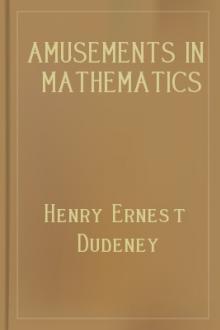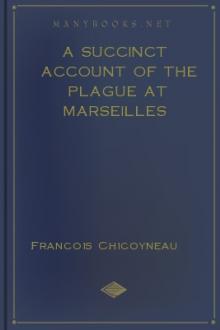Amusements in Mathematics, Henry Ernest Dudeney [books to read to be successful txt] 📗

- Author: Henry Ernest Dudeney
- Performer: 0486204731
Book online «Amusements in Mathematics, Henry Ernest Dudeney [books to read to be successful txt] 📗». Author Henry Ernest Dudeney

In Diagram D I give another familiar puzzle that first appeared in a book published in Brussels in 1789, Les Petites Aventures de Jerome Sharp. Place seven counters on seven of the eight points in the following manner. You must always touch a point that is vacant with a counter, and then move it along a straight line leading from that point to the next vacant point (in either direction), where you deposit the counter. You proceed in the same way until all the counters are placed. Remember you always touch a vacant place and slide the counter from it to the next place, which must be also vacant. Now, by the "buttons and string" method of simplification we can transform the diagram into E. Then the solution becomes obvious. "Always move to the point that you last moved from." This is not, of course, the only way of placing the counters, but it is the simplest solution to carry in the mind.
There are several puzzles in this book that the reader will find lend themselves readily to this method.
342.—THE MANDARIN'S PUZZLE.—solution
The rather perplexing point that the solver has to decide for himself in attacking this puzzle is whether the shaded numbers (those that are shown in their right places) are mere dummies or not. Ninety-nine persons out of a hundred might form the opinion that there can be no advantage in moving any of them, but if so they would be wrong.
The shortest solution without moving any shaded number is in thirty-two moves. But the puzzle can be solved in thirty moves. The trick lies in moving the 6, or the 15, on the second move and replacing it on the nineteenth move. Here is the solution: 2, 6, 13, 4, 1, 21, 4, 1, 10, 2, 21, 10, 2, 5, 22, 16, 1, 13, 6, 19, 11, 2, 5, 22, 16, 5, 13, 4, 10, 21. Thirty moves.
343.—EXERCISE FOR PRISONERS.—solution
There are eighty different arrangements of the numbers in the form of a perfect knight's path, but only forty of these can be reached without two men ever being in a cell at the same time. Two is the greatest number of men that can be given a complete rest, and though the knight's path can be arranged so as to leave either 7 and 13, 8 and 13, 5 and 7, or 5 and 13 in their original positions, the following four arrangements, in which 7 and 13 are unmoved, are the only ones that can be reached under the moving conditions. It therefore resolves itself into finding the fewest possible moves that will lead up to one of these positions. This is certainly no easy matter, and no rigid rules can be laid down for arriving at the correct answer. It is largely a matter for individual judgment, patient experiment, and a sharp eye for revolutions and position.

As a matter of fact, the position C can be reached in as few as sixty-six moves in the following manner: 12, 11, 15, 12, 11, 8, 4, 3, 2, 6, 5, 1, 6, 5, 10, 15, 8, 4, 3, 2, 5, 10, 15, 8, 4, 3, 2, 5, 10, 15, 8, 4, 12, 11, 3, 2, 5, 10, 15, 6, 1, 8, 4, 9, 8, 1, 6, 4, 9, 12, 2, 5, 10, 15, 4, 9, 12, 2, 5, 3, 11, 14, 2, 5, 14, 11 = 66 moves. Though this is the shortest that I know of, and I do not think it can be beaten, I cannot state positively that there is not a shorter way yet to be discovered. The most tempting arrangement is certainly A; but things are not what they seem, and C is really the easiest to reach.
If the bottom left-hand corner cell might be left vacant, the following is a solution in forty-five moves by Mr. R. Elrick: 15, 11, 10, 9, 13, 14, 11, 10, 7, 8, 4, 3, 8, 6, 9, 7, 12, 4, 6, 9, 5, 13, 7, 5, 13, 1, 2, 13, 5, 7, 1, 2, 13, 8, 3, 6, 9, 12, 7, 11, 14, 1, 11, 14, 1. But every man has moved.
344.—THE KENNEL PUZZLE.—solution
The first point is to make a choice of the most promising knight's string and then consider the question of reaching the arrangement in the fewest moves. I am strongly of opinion that the best string is the one represented in the following diagram, in which it will be seen that each successive number is a knight's move from the preceding one, and that five of the dogs (1, 5, 10, 15, and 20) never leave their original kennels.

This position may be arrived at in as few as forty-six moves, as follows: 16—21, 16—22, 16—23, 17—16, 12—17, 12—22, 12—21,7—12, 7—17, 7—22, 11—12, 11—17, 2—7, 2—12, 6—11, 8—7, 8—6, 13—8, 18—13, 11—18, 2—17, 18—12, 18—7, 18—2, 13—7, 3—8, 3—13, 4—3, 4—8, 9—4, 9—3, 14—9, 14—4, 19—14, 19—9, 3—14, 3—19, 6—12, 6—13, 6—14, 17—11, 12—16, 2—12, 7—17, 11—13, 16—18 = 46 moves. I am, of course, not able to say positively that a solution cannot be discovered in fewer moves, but I believe it will be found a very hard task to reduce the number.
345.—THE TWO PAWNS.—solution
Call one pawn A and the other B. Now, owing to that optional first move, either pawn may make either 5 or 6 moves in reaching the eighth square. There are, therefore, four cases to be considered: (1) A 6 moves and B 6 moves; (2) A 6 moves and B 5 moves; (3) A 5 moves and B 6 moves; (4) A 5 moves and B 5 moves. In case (1) there are 12 moves, and we may select any 6 of these for A. Therefore 7 × 8 × 9 × 10 × 11 × 12 divided by 1 × 2 × 3 × 4 × 5 × 6 gives us the number of variations for this case—that is, 924. Similarly for case (2), 6 selections out of 11 will be 462; in case (3), 5 selections out of 11 will also be 462; and in case (4), 5 selections out of 10 will be 252. Add these four numbers together and we get 2,100, which is the correct number of different ways in which the pawns may advance under the conditions. (See No. 270, on p. 204.)
346.—SETTING THE BOARD.—solution
The White pawns may be arranged in 40,320 ways, the White rooks in 2 ways, the bishops in 2 ways, and the knights in 2 ways. Multiply these numbers together, and we find that the White pieces may be placed in 322,560 different ways. The Black pieces may, of course, be placed in the same number of ways. Therefore the men may be set up in 322,560 × 322,560 = 104,044,953,600 ways. But the point that nearly everybody overlooks is that the board may be placed in two different ways for every arrangement. Therefore the answer is doubled, and is 208,089,907,200 different ways.
347.—COUNTING THE RECTANGLES.—solution
There are 1,296 different rectangles in all, 204 of which are squares, counting the square board itself as one, and 1,092 rectangles that are not squares. The general formula is that a board of n2 squares contains ((n2 + n)2)/4 rectangles, of which (2n3 + 3n2 + n)/6 are squares and (3n4 + 2n3 - 3n2 - 2n)/12 are rectangles that are not squares. It is curious and interesting that the total number of rectangles is always the square of the triangular number whose side is n.
348.—THE ROOKERY.—solution
The answer involves the little point that in the final position the numbered rooks must be in numerical order in the direction contrary to that in which they appear in the original diagram, otherwise it cannot be solved. Play the rooks in the following order of their numbers. As there is never more than one square to which a rook can move (except on the final move), the notation is obvious—5, 6, 7, 5, 6, 4, 3, 6, 4, 7, 5, 4, 7, 3, 6, 7, 3, 5, 4, 3, 1, 8, 3, 4, 5, 6, 7, 1, 8, 2, 1, and rook takes bishop, checkmate. These are the fewest possible moves—thirty-two. The Black king's moves are all forced, and need not be given.
349.—STALEMATE.—solution
Working independently, the same position was arrived at by Messrs. S. Loyd, E.N. Frankenstein, W.H. Thompson, and myself. So the following may be accepted as the best solution possible to this curious problem :—
And White is stalemated.
We give a diagram of the curious position arrived at. It will be seen that not one of White's pieces may be moved.

350.—THE FORSAKEN KING.—solution
Play as follows:—
Of course, by "royal row" is meant the row on which the king originally stands at the beginning of a game. Though, if Black plays badly, he may, in certain positions, be mated in fewer moves, the above provides for every variation he can possibly bring about.
351.—THE CRUSADER.—solution





Comments (0)